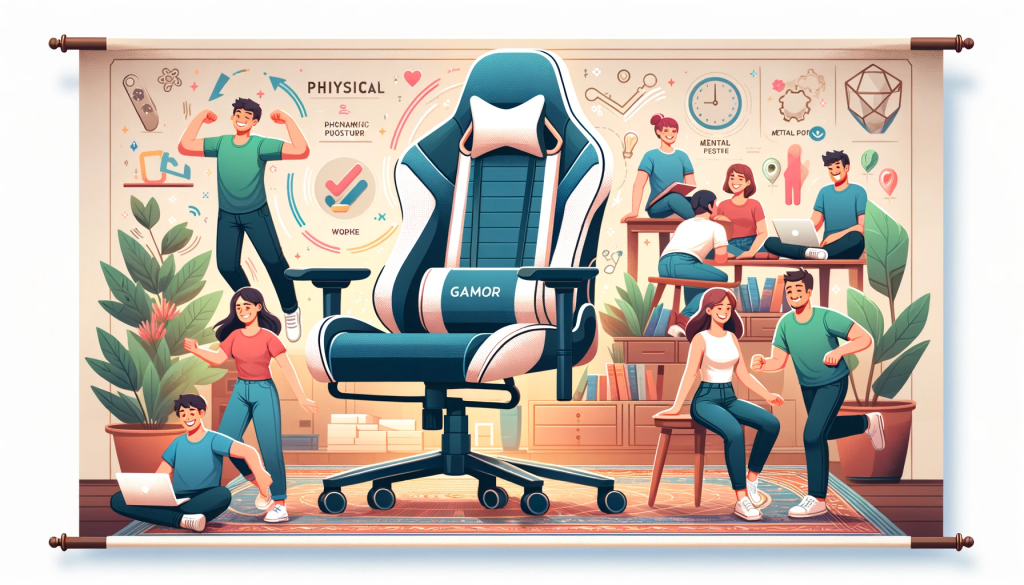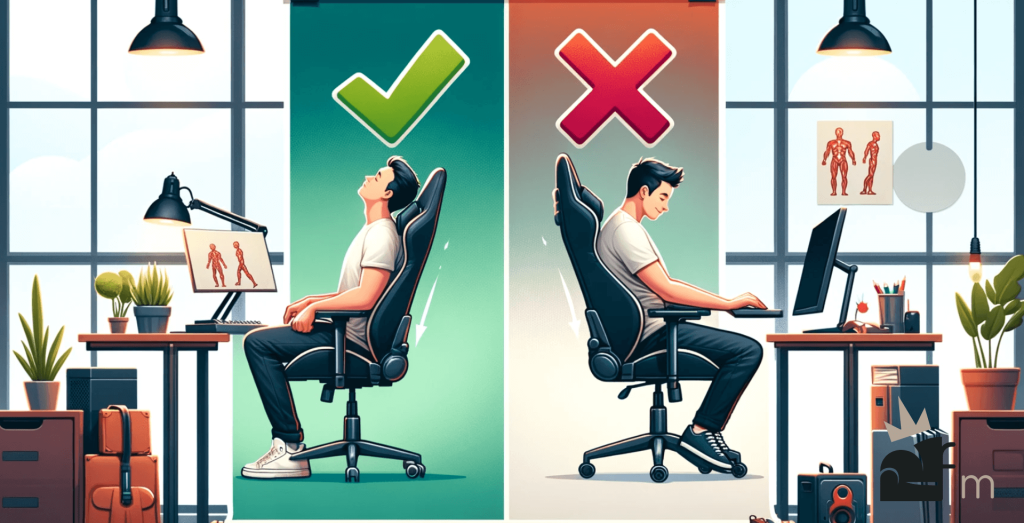There can be many reasons a gaming chair can hurt your back, but that gaming chair has to be broken or misshapen in different ways and doesn’t promote good sitting posture. Plus, we also need to consider many general addictive gaming behaviors can also be an issue for back pain.
Just think, manufacturers carefully create gaming chairs, keeping different objectives to make it more comfortable, elevate good posture, reduce back strain, and help you play your game for hours without any backlashes.
So, we can assume flawless gaming chairs will never cause you any back problems. That being said, let’s find out the real reasons for back complications in the first place.
- 10 Reason why Gaming Chairs can Hurt Your Back
- 1. The design flaws in your chair
- 2. The marathon sitting sessions you pull Off
- 3. The absence of lumbar support in your setup
- 4. How you’ve misjudged your chair’s height
- 5. Your cushion’s inadequate comfort level
- 6. The posture mistakes you’re making
- 7. Your sedentary lifestyle’s side effects
- 8. How your medical history plays a role
- 9. The material pitfall of your chair
- 10. The stress you carry on your shoulders
- 5 Exercises that can Help You Get Relief from Back Pain Caused by these Issues
- FAQ

10 Reason Why Gaming Chairs Can Hurt Your Back
If you’re questioning, “Why does my gaming chair hurt my back?” you’re not alone. Many people experience discomfort for various reasons. Various factors can contribute to back discomfort while gaming, and understanding them is the first step to finding relief.
Below, most of the issues we will mention are chair problems along with human behaviors and physical issues.
i. The design flaws in your chair
When it comes to back pain, the design of your gaming chair can be a major culprit. Chairs with limited adjustability can force you into uncomfortable postures, contributing to back strain over prolonged periods. For instance, fixed armrests might make you slouch or lean, thus affecting your spinal alignment.
ii. The marathon sitting sessions you pull off
The more you sit, the more stress you place on your back. If you’re involved in marathon gaming sessions that last for hours without taking short breaks, you’re overworking your back muscles and putting undue pressure on your spinal discs. Try to break up these marathons into smaller sessions and incorporate breaks.
iii. The absence of lumbar support in your setup
A gaming chair without proper lumbar support is like a ticking time bomb for your lower back. Chairs that lack a contoured backrest or lumbar pillows do not support the natural curve of your spine, leading to gradual discomfort and eventual pain. Investing in additional lumbar support can be a game-changer.
iv. How you’ve misjudged your chair’s height
Seat height is critical for maintaining good posture. If your chair is too high, you might find your feet dangling, which can lead to poor circulation and spinal misalignment. On the other hand, a chair that’s too low can cause your knees to be elevated above your hips, also affecting your posture.
v. Your Cushion’s Inadequate Comfort Level
Don’t underestimate the importance of a comfortable cushion. A seat that’s either too firm or too soft won’t provide adequate support, leading to pressure points and, ultimately, back pain. Chairs with memory foam cushions can adapt to your body shape, offering better support.
Why Does My Gaming Chair Keep Going Down?
vi. The posture mistakes you’re making
Posture plays a pivotal role in how you feel after a gaming session. Slouching or leaning too far forward can lead to strained back muscles and even injure spinal ligaments. Maintain a neutral spine position, and be conscious of how you sit, especially during intense gaming moments.
vii. Your sedentary lifestyle’s side effects
Remaining sedentary for extended periods can have broader health implications beyond back pain. Lack of physical movement can exacerbate muscle stiffness and reduce blood circulation, contributing to a feeling of discomfort or even numbness. Even simple activities like stretching or walking around during breaks can make a difference.
viii. How your medical history plays a role
Existing medical conditions like herniated discs, osteoporosis, or sciatica can be aggravated by prolonged sitting in a gaming chair, especially one that isn’t ergonomically designed. If you have a medical condition that affects your back, consult healthcare professionals for customized advice on seating and posture.
ix. The material pitfall of your chair
Choosing the wrong material for your gaming chair can contribute to discomfort. For example, leather chairs, while luxurious, can get hot and sticky, causing discomfort over prolonged use. Materials like breathable mesh can offer a more comfortable alternative, allowing your skin to breathe.
x. The stress you carry on your shoulders
Emotional and psychological stress can add to your physical discomfort. When you’re stressed, you naturally tense up, which includes tightening the muscles in your back. This added tension can make any existing back pain even worse. Stress-management techniques like deep breathing or mindfulness can help relieve this tension during gaming sessions.
5 Physical Exercises that can Help You Get Relief from Back Pain

With these exercises, you can easily get rid of any back pain you might encounter while sitting in your gaming chair.
1. Spinal stretches can counteract design flaws in your chair
If the design of your chair is lacking, your back can suffer as a result. Engage in spinal stretches to help elongate the spine and relieve pressure. Simply reach both arms above your head and stretch upward while seated or standing. Hold for a few seconds, and release. This simple stretch can be an effective countermeasure against the discomfort caused by a poorly designed chair.
2. Short walks for marathon sitting sessions
Hours of continuous sitting can be detrimental to your back. To alleviate the strain, make it a habit to take 5-10 minute walks every hour. These short walks encourage blood flow, give your back muscles a break, and allow your spine to realign. This activity is more than just a simple break; it’s a health necessity for anyone engaged in long gaming sessions.
3. Lower back press can be used for absence of lumbar support
When your chair lacks proper lumbar support, your lower back bears the brunt of the pressure. An effective exercise is the lower back press. Sit or stand upright and press the lower back with your hand, pushing slightly forward. Hold for 10 seconds and release. This engages your lower back muscles, giving them the support they lack from your chair.
4. Knee-to-chest stretch for incorrect chair height
Incorrect chair height can strain your back muscles and cause misalignment. To relieve this tension, try the knee-to-chest stretch. Sit on the edge of a stable chair and pull one knee toward your chest. Hold for a few seconds, then switch. This stretch helps to realign your spine and alleviates tension in the lower back.
5. Pelvic tilts work great for poor cushioning
A poor cushion can lead to back discomfort and muscle fatigue. A simple yet effective exercise to counter this is pelvic tilts. Sit straight in your chair and tilt your pelvis forward, then backward, engaging your abdominal muscles. This simple motion can relieve pressure on your back and strengthen your core.
Can Gaming Chair Improve Your Aim and Help You to Win the Battle?
FAQ on Why Does My Gaming Chair Hurt My Back
Do people think gaming chairs are bad for the back?
Public opinion on gaming chairs’ impact on back health is mixed. Some people believe that gaming chairs contribute to back pain due to design flaws like inadequate lumbar support or lack of adjustability.
However, it’s important to note that not all gaming chairs are created equal; there are models with ergonomic features specifically aimed at supporting back health. Additionally, the way one uses the chair, such as sitting duration and posture, can also influence its impact on the back.
How to get a good posture while sitting on a gaming chair?
Achieving good posture in a gaming chair involves more than just sitting up straight. Start by adjusting the chair’s height so that your feet are flat on the ground and your knees form a 90-degree angle. Your eyes should be level with the top of your computer screen to avoid neck strain.
Use any built-in lumbar support or add a cushion to support the lower back. Keep your elbows close to your body and ensure they form a 90-degree angle at the desk to minimize arm and wrist strain. Regular breaks and stretching are also crucial for maintaining good posture over extended periods.
What are the weaknesses of gaming chairs?
The weaknesses of gaming chairs often lie in their lack of ergonomic features. Some models come with limited adjustability, affecting your ability to find a comfortable sitting position tailored to your body type.
Lack of proper lumbar support can cause strain on your lower back, while poor cushioning can lead to discomfort during longer sitting sessions. Additionally, the materials used for the chair can sometimes be uncomfortable during prolonged use, like leather options that may become too warm.
Should gaming chairs be high or low?
The height of a gaming chair should facilitate a neutral posture. This means adjusting the chair so that your feet are flat on the ground and your knees are at a 90-degree angle. The height should also align your eyes with the top of your computer screen to prevent neck strain. Having your chair at the wrong height can lead to many issues, including poor blood circulation and increased pressure on your lower back and thighs.
Are gaming chairs good for study?
Gaming chairs can be appropriate for study sessions if they are ergonomically designed. Features to look for include adjustable armrests, proper lumbar support, and a reclining feature to occasionally shift your position.
A chair with these features can provide the sustained comfort needed for long study periods. However, just like with gaming, it’s important to take regular breaks to stretch and move around, reducing the risk of muscle stiffness or strain.
Our Verdict
We have to consider that back pain is a complex issue influenced by a range of factors, everything from chair design to your own sitting habits. But, as you can see, most of the time, pre-existing physical conditions are the reason for back issues.
Luckily, you’re not alone in your quest for a pain-free experience. Many gamers face similar challenges, and acknowledging the problem is an important milestone. Practical solutions are available, from adjusting your chair and workspace ergonomics to incorporating targeted physical exercises into your routine.
It’s crucial to remember that ongoing or severe back pain should be professionally evaluated. No amount of chair adjustments or exercises can substitute for expert medical advice. Back health is too important to leave to trial and error, so consider consulting a healthcare provider for a personalized treatment plan tailored to your specific needs.
Wishing you good health!

